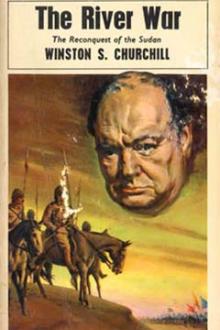The River War - Winston Churchill (books under 200 pages .txt) 📗

- Author: Winston Churchill
- Performer: -
Book online «The River War - Winston Churchill (books under 200 pages .txt) 📗». Author Winston Churchill
The position of a strong force at Merawi—only 120 miles along the river bank from Abu Hamed, the northern Dervish post—was, as will be seen, convenient to the continuance of the campaign whenever the time should arrive. But a long delay in the advance was now inevitable, and nearly a year was destined to pass without any collision between the forces of the Khedive and those of the Khalifa.
The success of the operations caused great public satisfaction in England.
The first step had been taken. The Soudan was re-entered. After ten years of defensive war the Dervishes had been attacked, and it was clear that when they were attacked with adequate forces they were not so very terrible after all. The croakers were silent. A general desire was manifested in the country that the operations should continue, and although the Government did not yet abandon their tentative policy, or resolve utterly to destroy the Khalifa’s power, it was decided that, as the road had so far been safe and pleasant, there was at present no need to stop or turn back.
A generous gazette of honours was published. With a single exception, which it would be invidious to specify, all the officers of the Egyptian army were mentioned in despatches. Sir H. Kitchener, Colonel Hunter, and Colonel Rundle were promoted Major-Generals for distinguished service in the field; a special medal—on whose ribbon the Blue Nile is shown flowing through the yellow desert—was struck; and both the engagement at Firket and the affair at Hafir were commemorated by clasps. The casualties during the campaign, including the fighting round Suakin, were 43 killed and 139 wounded; 130 officers and men died from cholera; and there were 126 deaths from other causes. A large number of British officers were also invalided.
It often happens that in prosperous public enterprises the applause of the nation and the rewards of the sovereign are bestowed on those whose offices are splendid and whose duties have been dramatic. Others whose labours were no less difficult, responsible, and vital to success are unnoticed. If this be true of men, it is also true of things. In a tale of war the reader’s mind is filled with the fighting. The battle—with its vivid scenes, its moving incidents, its plain and tremendous results—
excites imagination and commands attention. The eye is fixed on the fighting brigades as they move amid the smoke; on the swarming figures of the enemy; on the General, serene and determined, mounted in the middle of his Staff. The long trailing line of communications is unnoticed.
The fierce glory that plays on red, triumphant bayonets dazzles the observer; nor does he care to look behind to where, along a thousand miles of rail, road, and river, the convoys are crawling to the front in uninterrupted succession. Victory is the beautiful, bright-coloured flower.
Transport is the stem without which it could never have blossomed.
Yet even the military student, in his zeal to master the fascinating combinations of the actual conflict, often forgets the far more intricate complications of supply.
It cannot be denied that a battle, the climax to which all military operations tend, is an event which is not controlled by strategy or organisation. The scheme may be well planned, the troops well fed, the ammunition plentiful, and the enemy entangled, famished, or numerically inferior. The glorious uncertainties of the field can yet reverse everything. The human element—in defiance of experience and probability—
may produce a wholly irrational result, and a starving, out-manoeuvred army win food, safety, and honour by their bravery. But such considerations apply with greater force to wars where both sides are equal in equipment and discipline. In savage warfare in a flat country the power of modern machinery is such that flesh and blood can scarcely prevail, and the chances of battle are reduced to a minimum. Fighting the Dervishes was primarily a matter of transport. The Khalifa was conquered on the railway.
Hitherto, as the operations have progressed, it has been convenient to speak of the railway in a general manner as having been laid or extended to various points, and merely to indicate the direction of the lines of communication. The reader is now invited to take a closer view.
This chapter is concerned with boats, railways, and pack animals, but particularly with railways.
Throughout the Dongola campaign in 1896 the Nile was the main channel of communication between the Expeditionary Force and its base in Egypt.
All supplies were brought to the front as far as possible by water transport. Wherever the Nile was navigable, it was used. Other means of conveyance—by railways and pack animals—though essential, were merely supplementary. Boats carry more and cost less than any other form of transport. The service is not so liable to interruption; the plant needs only simple repair; the waterway is ready-made. But the Nile is not always available. Frequent cataracts obstruct its course for many miles.
Other long reaches are only navigable when the river is in flood.
To join the navigable reaches, and thus preserve the continuity of the communications, a complex system of railways and caravans was necessary.
In the expedition to Dongola a line of railway was required to connect the two navigable reaches of the Nile which extend from Assuan to Wady Halfa, and from Kerma to Merawi. Before the capture of Dongola, however, this distance was shortened by the fact that the river at high Nile is navigable between the Third Cataract and Kerma. In consequence it was at first only necessary to construct the stretch of 108 miles between Wady Halfa and Kosheh. During the years when Wady Halfa was the southernmost garrison of the Egyptian forces a strong post had been maintained at Sarras. In the Nile expeditions of 1885 the railway from Halfa had been completed through Sarras and as far as Akasha, a distance of eighty-six miles. After the abandonment of the Soudan the Dervishes destroyed the line as far north as Sarras. The old embankments were still standing, but the sleepers had been burnt and the rails torn up, and in many cases bent or twisted. The position in 1896 may, in fact, be summed up as follows: The section of thirty-three miles from Wady Halfa to Sarras was immediately available and in working order. The section of fifty-three miles from Sarras to Akasha required partial reconstruction. The section of thirty-two miles from Akasha to Kosheh must, with the exception of ten miles of embankment completed in 1885, at once be newly made. And, finally, the section from Kosheh to Kerma must be completed before the Nile flood subsided.
The first duty, therefore, which the Engineer officers had to perform was the reconstruction of the line from Sarras to Akasha. No trained staff or skilled workmen were available. The lack of men with technical knowledge was doubtfully supplied by the enlistment of a ‘Railway Battalion’ 800
strong. These men were drawn from many tribes and classes. Their only qualification was capacity and willingness for work. They presented a motley appearance. Dervish prisoners, released but still wearing their jibbas, assisted stalwart Egyptians in unloading rails and sleepers.
Dinkas, Shillooks, Jaalin, and Barabras shovelled contentedly together at the embankments. One hundred civilian Soudanese—chiefly time-expired soldiers—were also employed; and these, since they were trustworthy and took an especial pride in their work, soon learned the arts of spiking rails and sleepers, fishing rails together, and straightening.
To direct and control the labours of these men of varied race and language, but of equal inexperience, some civilian foremen platelayers were obtained at high rates of pay from Lower Egypt. These, however, with very few exceptions were not satisfactory, and they were gradually replaced by intelligent men of the ‘Railway Battalion,’ who had learned their trade as the line progressed. The projection, direction, and execution of the whole work were entrusted to a few subalterns of Engineers, of whom the best-known was Edouard Girouard.
Work was begun south of Sarras at the latter end of March. At first the efforts of so many unskilled workmen, instructed by few experienced officers, were productive of results ridiculous rather than important.
Gradually, however, the knowledge and energy of the young director and the intelligence and devotion of his still more youthful subordinates began to take effect. The pace of construction increased, and the labour was lightened by the contrivances of experience and skill.
As the line grew longer, native officers and non-commissioned officers from the active and reserve lists of the Egyptian Army were appointed station-masters. Intelligent non-commissioned officers and men were converted into shunters, guards, and pointsmen. Traffic was controlled by telephone. To work the telephone, men were discovered who could read and write—very often who could read and write only their own names, and even that with such difficulty that they usually preferred a seal.
They developed into clerks by a simple process of selection. To improve their education, and to train a staff in the office work of a railway, two schools were instituted at Halfa. In these establishments, which were formed by the shade of two palm-trees, twenty pupils received the beginnings of knowledge. The simplicity of the instruction was aided by the zeal of the students, and learning grew beneath the palm-trees more quickly perhaps than in the magnificent schools of civilisation.
The rolling stock of the Halfa-Sarras line was in good order and sufficient quantity, but the eight locomotives were out of all repair, and had to be patched up again and again with painful repetition.
The regularity of their break-downs prevented the regularity of the road, and the Soudan military railway gained a doubtful reputation during the Dongola expedition and in its early days. Nor were there wanting those who employed their wits in scoffing at the undertaking and in pouring thoughtless indignation on the engineers. Nevertheless the work went on continually.
The initial difficulties of the task were aggravated by an unexpected calamity. On the 26th of August the violent cyclonic rain-storm of which some account has been given in the last chapter broke over the Dongola province.
A writer on the earlier phases of the war [A. Hilliard Atteridge, TOWARDS FREEDOM.] has forcibly explained why the consequences were so serious:
‘In a country where rain is an ordinary event the engineer lays his railway line, not in the bottom of a valley, but at a higher level on one slope or the other. Where he passes across branching side valleys, he takes care to leave in all his embankments large culverts to carry off flood-water. But here, in what was thought to be the rainless Soudan, the line south of Sarras followed for mile after mile the bottom of the long valley of Khor Ahrusa, and no provision had been made, or had been thought necessary, for culverts in the embankments where minor hollows were crossed. Thus, when the flood came, it was not merely that the railway was cut through here and there by the rushing deluge. It was covered deep in water, the ballast was swept away, and some of the banks so destroyed that in places rails and sleepers were left hanging in the air across a wide gap.’
Nearly fourteen miles of track were destroyed. The camp of the construction gangs was wrecked and flooded. Some of the rifles of the escort—for the conditions of war were never absent—were afterwards recovered from a depth of three feet of sand. In one place, where the embankment had partly withstood the deluge, a great lake several miles square appeared.
By extraordinary exertions the damage was repaired in a week.





Comments (0)